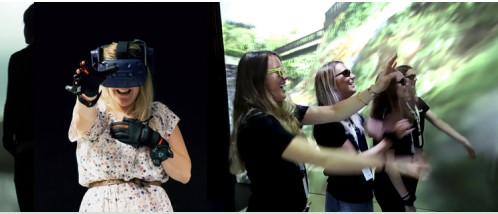Virtual reality interactions with autonomous vehicles – a new SAFER pre-study to start up in January
In the last call for SAFER pre-studies to start up in January 2021, the project "Virtual reality interactions with autonomous vehicles" was approved and funding was granted. The pre-study will focus on using virtual reality to study interactions with connected and automated vehicles from the perspective of vulnerable road users. The overall aim of the pre-studies is to support strategic knowledge creation that can lead SAFER forward and contribute to the continued development of the joint collaboration platform.
Will an autonomous vehicle hit a distracted pedestrian looking at its phone at a crossroad? How can we prevent a collision between an e-scooter and an e-bike? The introduction of smart and sustainable mobility solutions poses this type of new challenges when it comes to safety. In fact, transportation is rapidly changing with the introduction of new transportation modes re-shaping our mobility and it is important that traffic safety research keeps pace with technological advances.
The new SAFER pre-study project will focus on using virtual reality to study interactions with connected and automated vehicles from the perspective of a vulnerable road user, either a pedestrian or a bicyclist. The project is based in the newly established virtual reality hub on Traffic Safety and integration at Lund University and aims to explore how a VR environment can be used to study interactions between connected automated vehicles (CAVs) and both pedestrians and bicyclists. The project includes a qualitive approach focused on how a vulnerable road user perceive an oncoming CAV in different scenarios and a quantitative approach which focus on the movement of the road user within the VR environment. Finally, the project will also begin to explore how a qualitive and quantitative approach should be combined into a single analysis.
Newly established virtual reality hub
The virtual reality hub on Traffic Safety at Lund University is a newly established VR hub managed by the Transport and Roads division. The main aim of the VR hub is to investigate the safety issues of novel sustainable transportation means including CAVs, e-scooters and e-bikes. VR can allow for tests of many different types of autonomous behavior in various types of infrastructure outside the scope of what is feasible to test in the real world.
Five partners working together
As many as five partners will work together in this project; Lund University, VTI, Autoliv, Volvo Group and the Swedish transport administration. The project’s main aim is to provide the necessary foundation for larger projects with focus on how different infrastructure designs and behavior of connected and automated vehicles affect the behavior and perceptions of vulnerable road users. The expected further outcomes of the pre-study are to set up relevant research questions, plan the activities and equipment to acquire in the Lund University Traffic Safety VR Hub, and prepare a research idea and the consortium that can fit in a larger call.
Lund University will provide the experience in the analysis of dangerous situations and the quantitative parameters to investigate in the simulated environment. VTI will set up the qualitative study, by providing the behavioral insight - with expertise in the field of traffic psychology. Volvo Group Trucks Technology and Autoliv will provide the vehicle perspective by identifying the most relevant use cases that need to be investigated. Since CAVs will operate in public spaces, The Swedish Transport Administration will contribute by providing the infrastructure perspective, by localizing critical sites or infrastructure conditions that can be particularly hazardous in the interaction between CAVs and pedestrian and cyclists.
The SAFER Pre-studies
One of the news in the collaboration agreement for SAFER Stage 5 is that we offer research funding to pre-studies and seed-projects. The aim is to support strategic knowledge creation that can lead SAFER forward and contribute to the continued development of the joint collaboration platform. The main idea is to bring together a strategic group of collaborat¬ing partners to create unique, new competence as a basis for e.g. national funding or an entry ticket to prestigious international collaborations. We also welcome proposals that are of a different nature, for instance for finalization of publications from a completed project or investigation of a new area. Simply put, projects that lead SAFER forward and contribute to the continued development of our joint collaboration platform, have been welcomed.
Next call opens in January
All in all, in 2020, 15 project ideas have been submitted and 9 approved. The next call opens in January and closes end February.
• February 8: Research area day – dialogue about ideas within the Reference groups (recommended).
• Until February 28: Fill in the pre-study application and submit here: https://tinyurl.com/saferprestudy
• March 4: The Scientific Council (research area directors and part of the SAFER management team) evaluates and ranks all pre-study applications.
• March 11: The SAFER Board decides about funding.
• Mid March: Decision Letters are sent out.
• Start reports and final reports are due one month after projects start resp. end date.
Welcome with your application!

